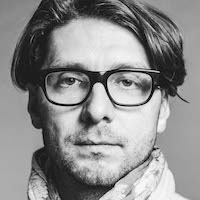But things are not so straightforward. At Kaluzhskaya, the three office buildings are joined by two residential towers on the western side.
Stone Grain housing complex
Copyright: © Kleinewelt Architekten / Stone Developer
The towers, rectangular in plan, are oriented along the north-south axis, advantageous for housing. One rises 45 stories, reaching 165 meters – not quite a skyscraper by Moscow standards, but still impressively tall. It has six elevators. The second has 20 stories and four elevators. Both are slender, especially in profile.
Here arises the question of unity and integrity in an ensemble that combines two completely different functions. On the one hand, the proximity of residential and office buildings developed by the same company is a positive: it forms a cohesive, multifaceted complex. As many dream, one could both live and work here, without wasting hours and hours on daily commutes.
On the other hand, this presents an architectural challenge: if you are an ambitious author – and Kleinewelt undoubtedly are – it’s not enough to regard the neighboring volumes as mere context. The connection is deeper: you must reveal both similarities and distinctions – all within a concise, contemporary aesthetic.
The 165-meter residential tower is noticeably taller than the office buildings, and that alone makes the pair – both vertically elongated – appear even more slender and upright.
Replacing the light metal lamellas and U-shaped plan – a distinctive, sharply modernist feature of the business center – the residential towers adopt a checkered grid of clinker brick. Its color is designed as a gradient, shifting from graphite at the lower levels to light gray at the top. The grid unites two floors and four windows per square, making this square the façade module for the residential towers. So, whereas before we might have spoken about “grouping floors vertically by two, three, or five” to visually elongate the volume – now there’s no need for that.
The towers are slender by their very proportions. That, in itself, is pleasing.
Stone Grain housing complex, a project
Copyright: © Kleinewelt Architekten / Stone Developer
Conservative brick and a “calm” square – and suddenly, such striking verticality. Technically, each end façade holds six windows.
Unlike the office buildings, whose tops are sharply cut – almost like the famous Dom Turista (“Tourist House”) – the taller tower avoids diagonals. Instead, it emphasizes its cubic structure, almost in a Minecraft-like way. Along its eastern edge, it steps down toward the office buildings with terraced levels, arranged more than 100 meters above the ground. These will be generous terraces offering sweeping city panoramas in a bluish haze.
Another feature of the tall tower is the presence of “gallery balconies.” They structure the vertical form, visually dividing it into three parts: six squares at the base, four in the middle, and ten above. The term “gallery balconies” was new to me in this project. According to the architects’ notes, the balconies will join two windows where they belong to a single apartment; where two apartments share a balcony, they will be separated by a glass partition. In other words, from a practical standpoint, these balconies are not true galleries – rather, open balconies are grouped on the façades in compositions that play an important volumetric role. Nevertheless, the presence of both terraces and balconies in the main tower adds variety to the apartment layout.
In any case, the balconies form bands of recesses that are crucial for the building’s volumetric composition. It’s also easy to see that the office towers have similar, if subtler, horizontal bands – showing the architects’ unified approach to form-making. And one more nuance worth noting: the building’s vertical division seems tripartite, classical in spirit – yet it has nothing in common with the traditional base/shaft/capital pattern. Quite the opposite: the proportions are non-classical, with the middle smaller than both the top and bottom. This effect is enhanced by the stepped terraces above – as if the building were preparing to “lift off” in cubic modules or displaying its readiness to dock with something above.
In other words, its form is deliberately unfinished – echoing the slanted tops of the office buildings, but in a more explicit, emphatic way.
The second, 20-story building – the “small” one – is a different matter. Being the smaller of the two, it’s placed deeper within the block, in a more sheltered spot. For similar reasons, its roof is given a gabled shape, reminiscent of Dutch motifs and the imagery from our childhood book “Hans Brinker, or The Silver Skates” – especially in combination with the overall silvery tone of the complex.
But wait – what gable are we talking about? It’s not really a gable at all, or at least only at the ends: there we see the pointed, “Northern European” silhouette, but along the longitudinal facades there are large attic-like volumes… No, not attics either – rather, terraces framed by projecting buttress-like elements. All of this replaces the pitched roof, originally devised in our latitudes for easy snow runoff. In any case, there’s no doubt that underfloor heating and snow removal are provided for, or soon will be.
But the apartments themselves – they deserve a special mention! Looking from the inside, we can see that the upper levels allow for fireplaces and two-level units with elegant spiral staircases. And most importantly, the four-window grid we mentioned earlier can remain as four separate windows – or merge into one large living-room window divided into four panes. Oddly enough, the association that comes to mind is not Paris or Florence, where such one-and-a-half- or two-story apartments are common, but rather the Narkomfin Building.
There are also smaller apartments here, and even studios.
As for the brick – it’s of an elongated “plinth” type, quite unlike the typical Moscow brickwork. But that’s no criticism. On the contrary, it’s a fresh perspective. And after all, Peter the Great himself had a fondness for Dutch influences.


















































